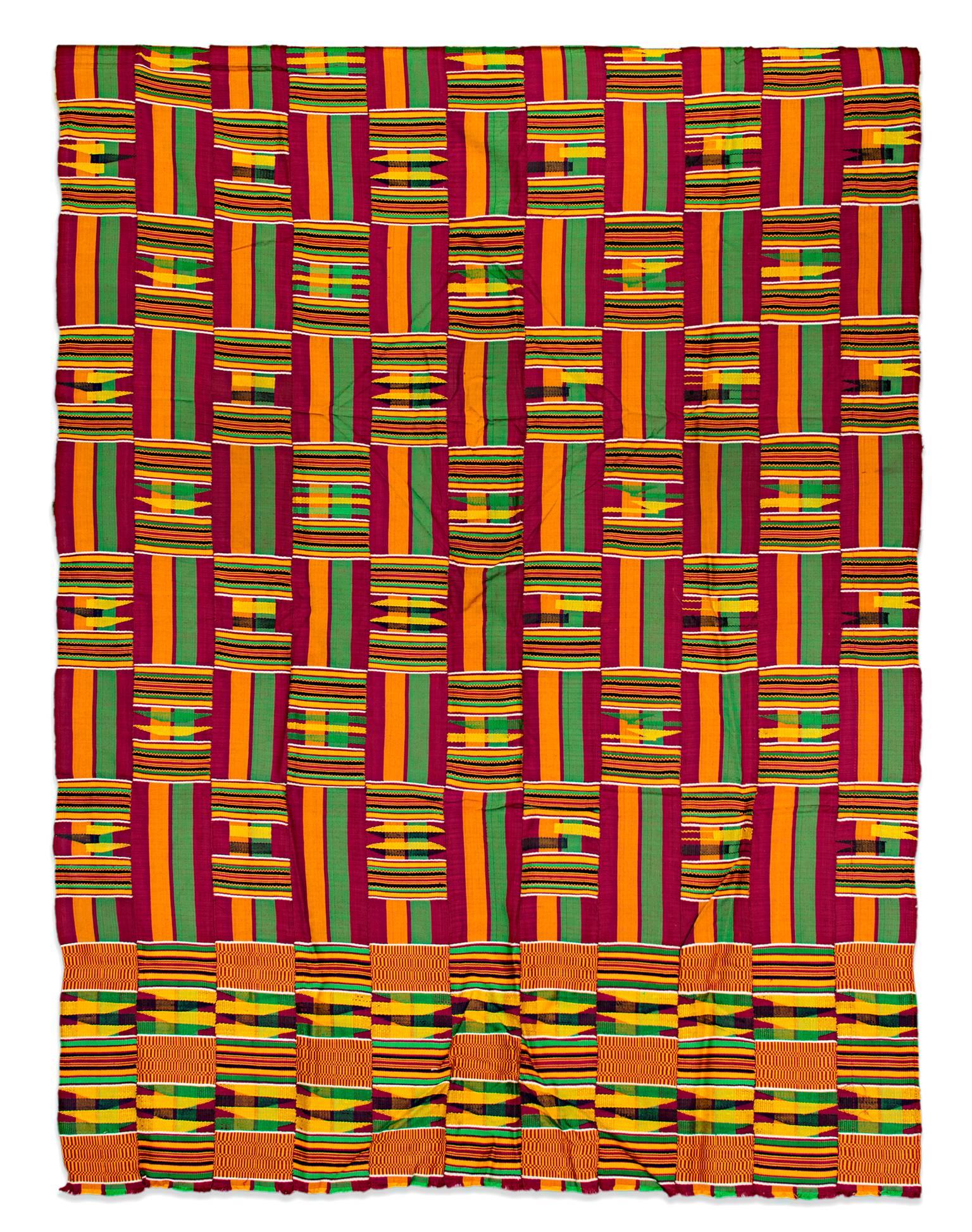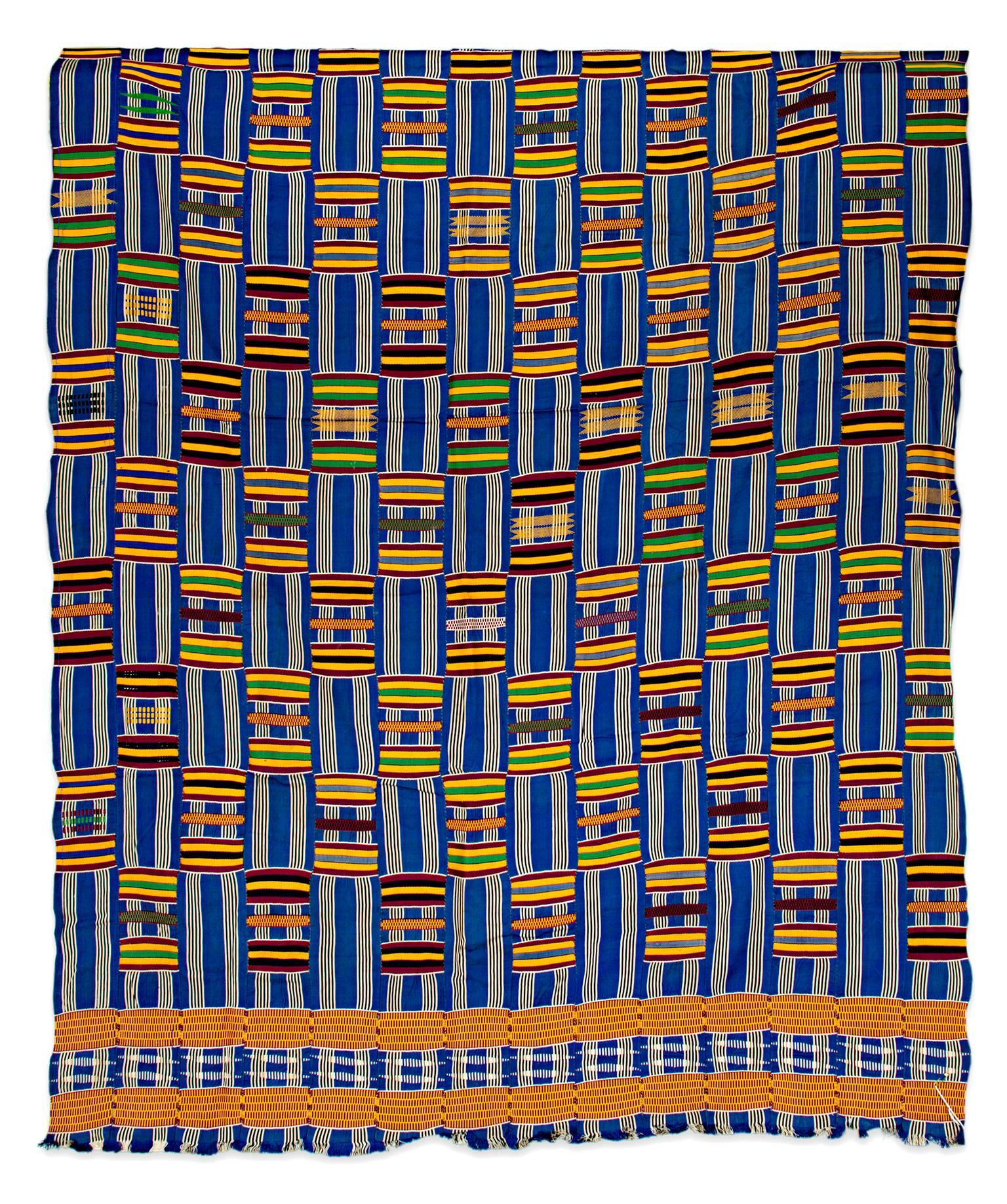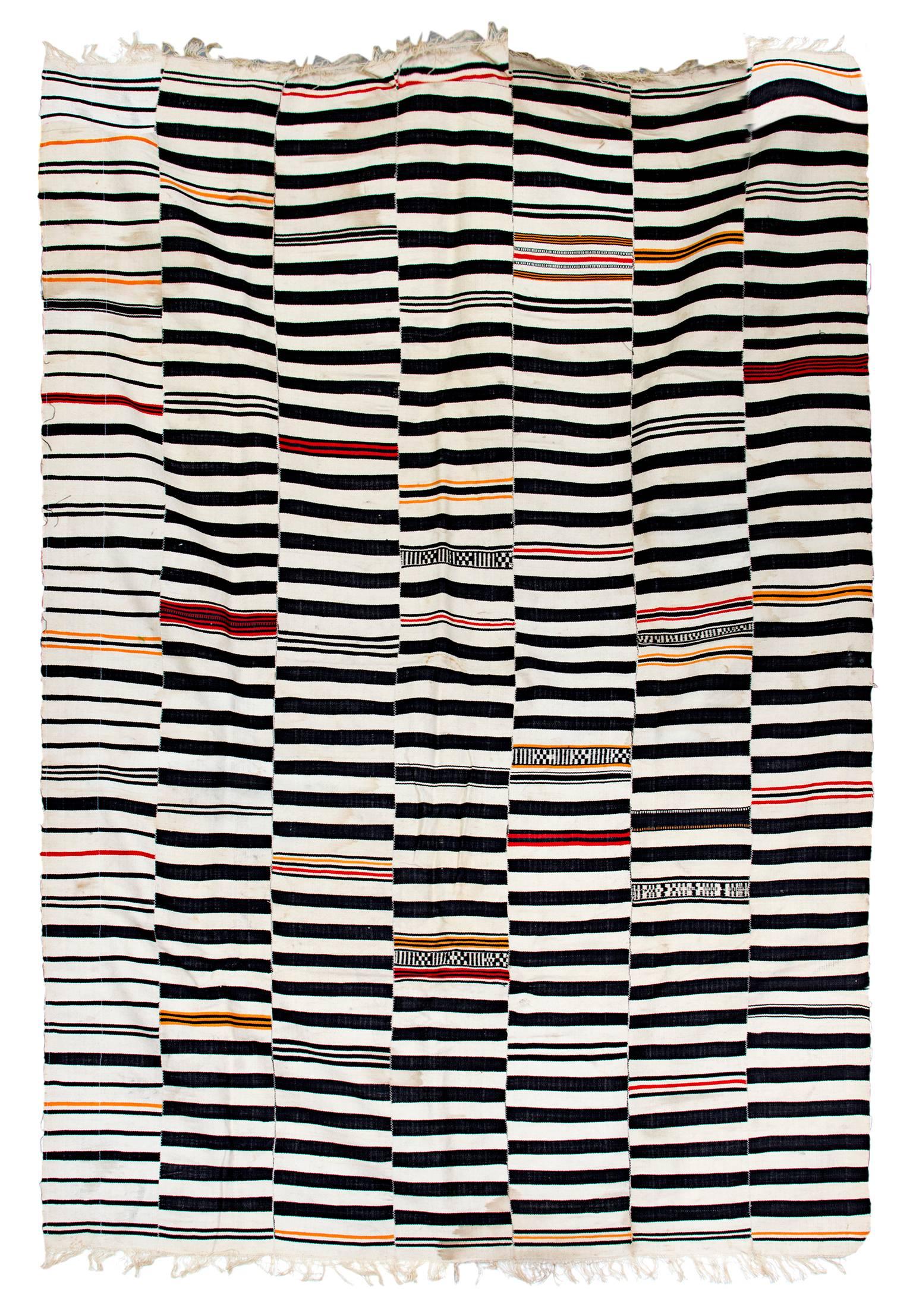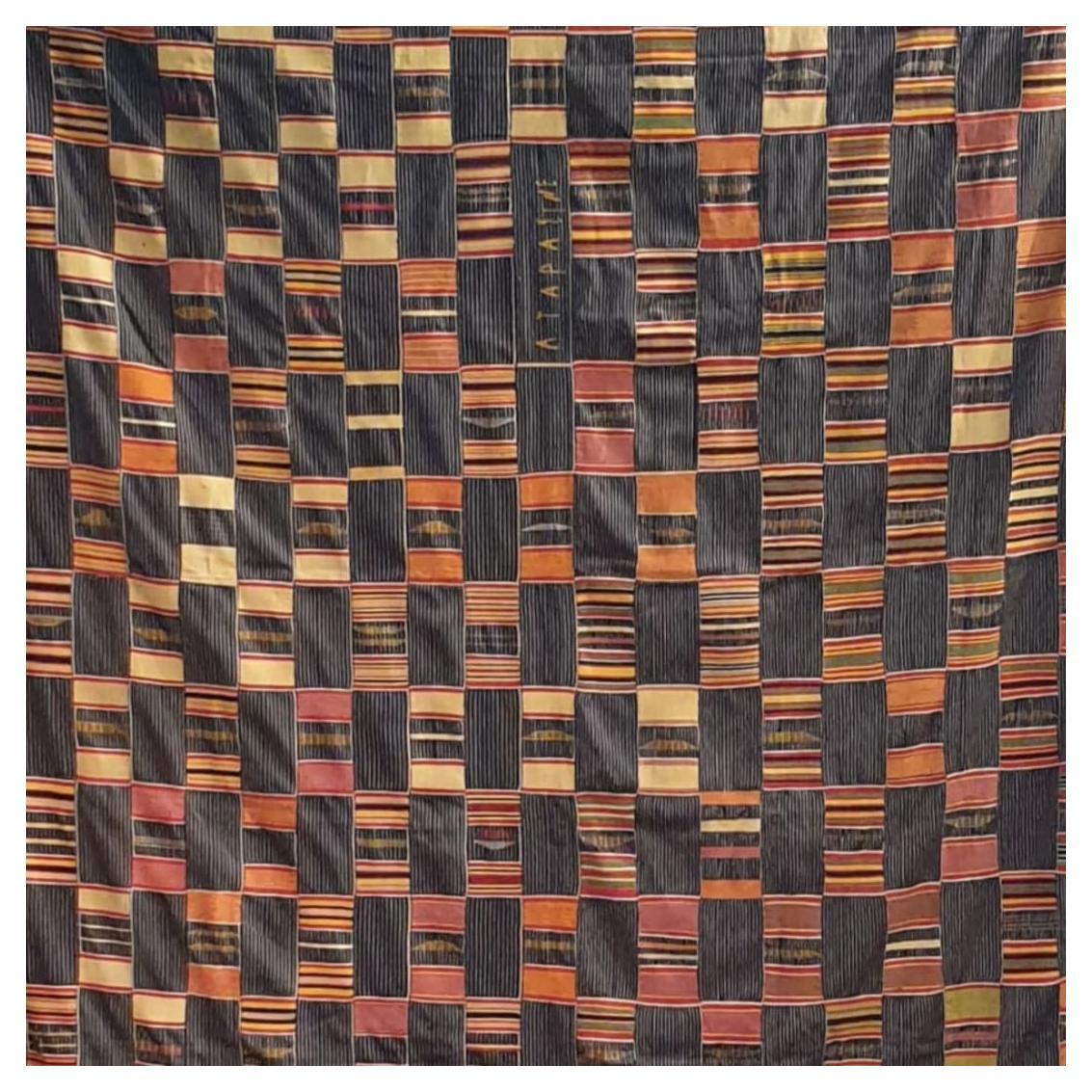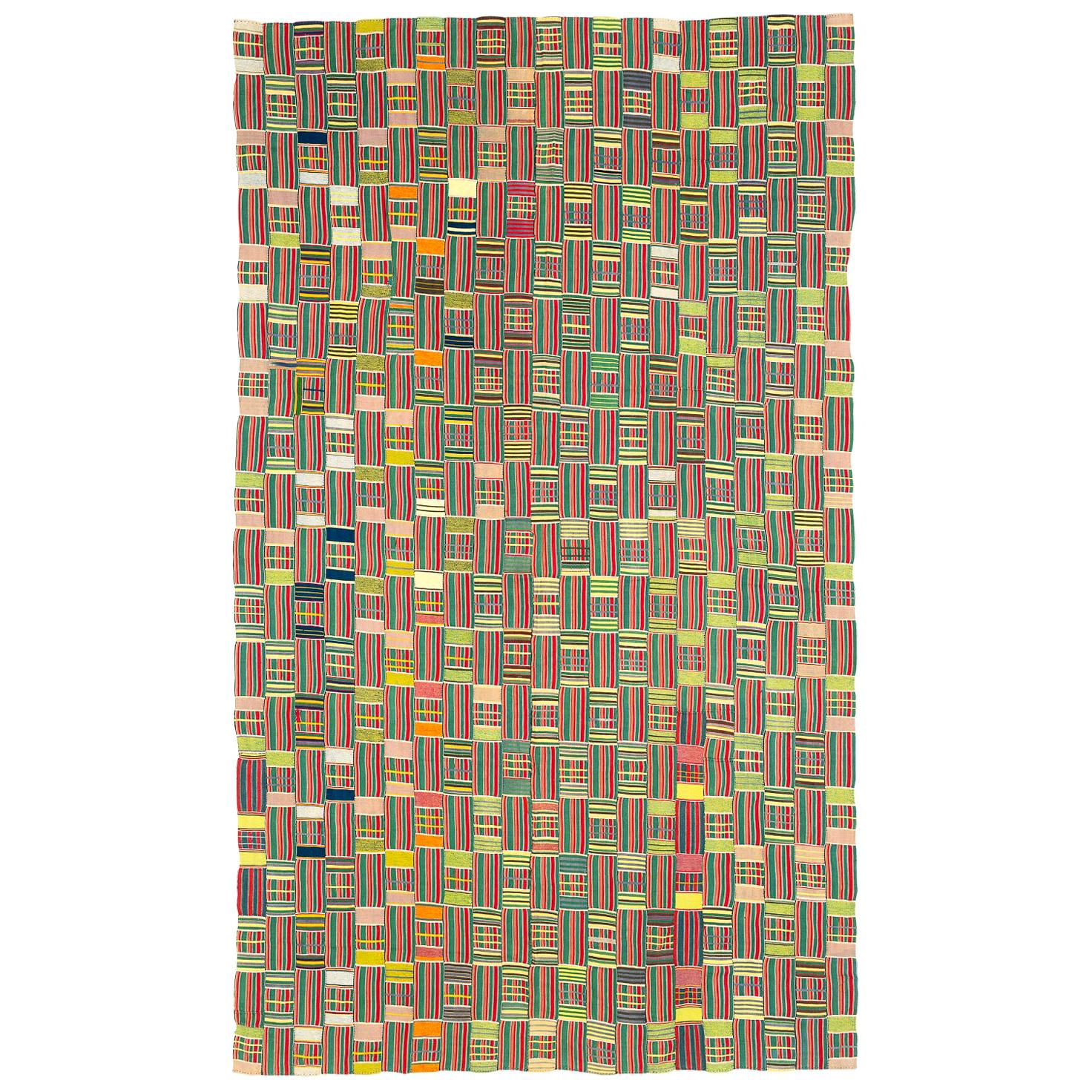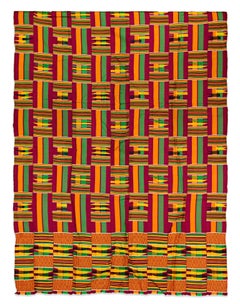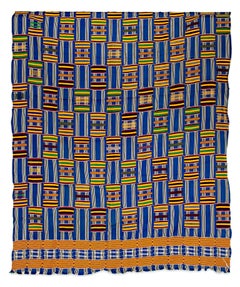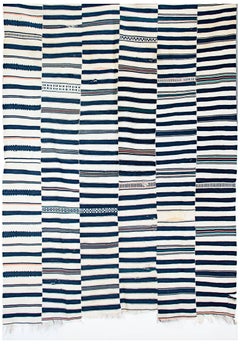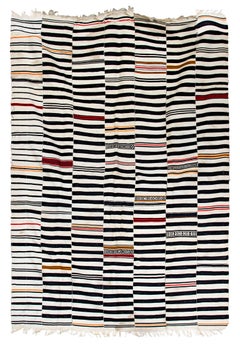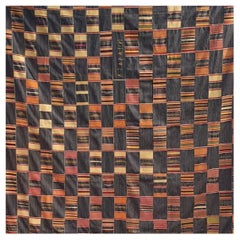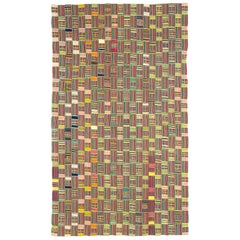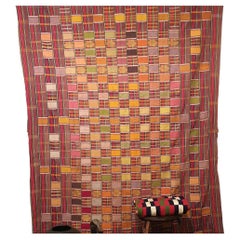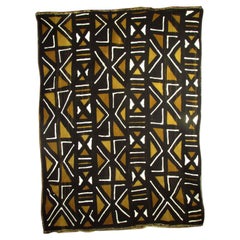Items Similar to "Tribal Cloth, Ewe Ghana, " Multicolored Cotton Textile created circa 1965
Want more images or videos?
Request additional images or videos from the seller
1 of 7
Unknown"Tribal Cloth, Ewe Ghana, " Multicolored Cotton Textile created circa 1965circa 1965
circa 1965
$6,525
£4,924.24
€5,637.51
CA$9,202.41
A$10,103.10
CHF 5,270.81
MX$122,261.60
NOK 66,061.42
SEK 62,247.23
DKK 42,082.49
About the Item
The Ewe people from Ghana are master weavers. People of means commission cloths called adanudo ("skilled/wise cloths"). Ewe adanudo textiles often display a tweed effect by twisting together different colored threads in many of the warps. Two things distinguish traditional Ewe weaving from Asante weaving: 1) the use of cotton rather than silk or rayon; and 2) the introduction of floating weft patterns of a figurative nature into some of the warp-faced sections of a strip. Today, however, much of the weaving is done with rayon (although the featured cloth is cotton). The textiles, unlike those of the Asante, may also incorporate pictorial symbols and figural motifs or people, plants, animals, and objects. Motifs include knives, hands (what we have we hold), keys (to the castle), chiefs' fly whisks, and musical instruments. Significantly, each motif has a proverbial meaning. Like the Asante, Ewe weavers us the same type of loom, and the weaving and sewing are also done by men.
About the Seller
4.9
Platinum Seller
Premium sellers with a 4.7+ rating and 24-hour response times
Established in 1966
1stDibs seller since 2017
447 sales on 1stDibs
Typical response time: 3 hours
- ShippingRetrieving quote...Shipping from: Milwaukee, WI
- Return Policy
Authenticity Guarantee
In the unlikely event there’s an issue with an item’s authenticity, contact us within 1 year for a full refund. DetailsMoney-Back Guarantee
If your item is not as described, is damaged in transit, or does not arrive, contact us within 7 days for a full refund. Details24-Hour Cancellation
You have a 24-hour grace period in which to reconsider your purchase, with no questions asked.Vetted Professional Sellers
Our world-class sellers must adhere to strict standards for service and quality, maintaining the integrity of our listings.Price-Match Guarantee
If you find that a seller listed the same item for a lower price elsewhere, we’ll match it.Trusted Global Delivery
Our best-in-class carrier network provides specialized shipping options worldwide, including custom delivery.More From This Seller
View All"Kente Cloth Ashanti Tribe, Ghana, " Silk and Cotton Weaving created circa 1970
Located in Milwaukee, WI
This silk and cotton fabric was made by an unknown Ashanti artist. It features green and orange accents. The Ashanti are a major ethnic group of the Akans in Ghana, a fairly new nation, barely more than 50 years old. Ghana, previously the Gold Coast, was a British colony until 1957. It is now politically separated into four main parts. Ashanti is in the center and Kumasi is the capital.
The Ashanti have a wide variety of arts. Bark cloth was used for clothing before weaving was introduced. With weaving, there is cotton and silk. Women may pick cotton...
Category
1970s Folk Art More Art
Materials
Cotton, Silk
"Fabric - Ashanti Tribal Cloth, " Silk Weaving from Africa circa 1930
Located in Milwaukee, WI
Among the most well-known West African textiles is kente cloth, woven by the Ewe and Asante peoples of Ghana. The word kente is not used by the Asante people; it may be derived from ...
Category
1930s Folk Art More Art
Materials
Silk
"Kente Cloth, Ashanti Tribe Ghana, " Cotton Weaving created circa 1970
Located in Milwaukee, WI
This cotton fabric was made by an unknown Ashanti artist. It is mostly black and white. The Ashanti are a major ethnic group of the Akans in Ghana, a fairly new nation, barely more than 50 years old. Ghana, previously the Gold Coast, was a British colony until 1957. It is now politically separated into four main parts. Ashanti is in the center and Kumasi is the capital.
The Ashanti have a wide variety of arts. Bark cloth was used for clothing before weaving was introduced. With weaving, there is cotton and silk. Women may pick cotton...
Category
1970s Folk Art More Art
Materials
Cotton
"Fulani Body Wrap Tribal cloth, Gambia, " Cloth created c. 1970
Located in Milwaukee, WI
This tribal cloth was created by an unknown artist from the Fulani tribe in Gambia, Africa. This tribe has a population numbering between 20 and 25 millio...
Category
1970s More Art
Materials
Fabric, Textile
"Ceremonial Hunting Shirt - Yoruba, Nigeria, " Glass Beads, Shells, & Cloth
Located in Milwaukee, WI
For the Yoruba people of Nigeria, beads and shells are applied to ceremonial garments and headdresses. Beads are an important part of Yoruba culture. henry John Drewal has written th...
Category
1940s Folk Art More Art
Materials
Fabric, Glass, Found Objects
Egyptian Wool Woven Tapestry Bright Colorful Abstract Contemporary Prayer World
By Joan Ward Summers
Located in Milwaukee, WI
"Egyptian Prayer Rug" is a wool tapestry by Joan Ward Summers. It was created in an edition of three and depicts a camel standing atop a column. With a geyser erupting in blue and br...
Category
1980s More Art
Materials
Tapestry, Wool
You May Also Like
Ewe Kente
By Ewe People
Located in Glasgow, GB
This is a fine piecevof Kente Textile from the Ewe people of the Volta region of Ghana. Woven from handspun cotton and natural dyes. This is a prestige cloth worn by a high ranking Elder of the Ewe people. The pattern denotes the individuals high status within the community with the dark blue background indicating the wisdom and knowledge of the owner. This piece will date from the 1930's and is in very fine condition. Ewe Kente...
Category
Vintage 1930s Ghanaian Tribal Tribal Art
Materials
Cotton
Vintage Multicolor West African Ewe Kente Cloth Textile Fabric or Wall Hanging
Located in New York, NY
This prestigious Kente cloth was handwoven on small hand held looms. The fabric has all been hand sewn to form a marvelous textile. These were originally m...
Category
Mid-20th Century Ghanaian Tribal Quilts and Blankets
Materials
Cotton
Ewe Kente
By Green Grove Weavers
Located in Glasgow, GB
This is a fine old piece of Royal Ewe Kente from arpund 1930.
Kente textile is a Royal Textile of the Ewe people of Ghana . This piece would have been worn...
Category
Vintage 1930s Ghanaian Tribal Tribal Art
Materials
Cotton
Mud Cloth 'Bogolanfini', Mali, Bamana People, Mid-20th Century
Located in Ottawa, Ontario
A mud cloth (Bogolanfini),
Mali, Bamana People
mid-20th century.
Hand woven 'discharge dyed' cotton
Approximately 71 x 52 in. (180cm. x 132cm.)
A dazzling geometric pattern...
Category
Mid-20th Century Malian Tribal Tribal Art
Materials
Fabric
20th Century Bamileke Textile Hanging, Ndop
Located in Point Richmond, CA
Ndop Panel
Bamileke people
Cameroon Grasslands
Cotton strip weave with a two part dyeing process: stitch-resist indigo dye on a pre-dyed cloth.
Measures: 39 x 59 1/2 inches (99 ...
Category
20th Century Cameroonian Tribal Tribal Art
Materials
Cotton
Hand Crafted Kuba Cloth Wall Hanging from D.R. Congo, 1960's
Located in Grythyttan, SE
The Kuba cloth (velours du kasai) is a captivating piece of textile art hailing from the Kasai Region in the Democratic Republic of the Congo. Crafted by hand in the 1960s, this Kuba cloth wall hanging is a testament to the rich cultural heritage and artistic traditions of the Kuba people.
The textile features a meticulous process of handweaving and embroidery using raffia palm fibers, showcasing intricate geometric patterns. The use of natural pigments in the dyeing process adds an earthy and authentic touch to the piece.
As a vintage item, this Kuba Cloth is not only a stunning decorative element but also a tangible link to the past, carrying with it the history and craftsmanship of the Kuba people. Its authenticity is underscored by the fact that each Kuba cloth is one of a kind, reflecting the unique artistic expression of the weaver.
Whether displayed as a wall hanging, used as a textile accent, or incorporated into interior design, the Kuba cloth invites a sense of cultural richness and historical significance. Embrace the beauty of this vintage, authentic artifact...
Category
Vintage 1960s Congolese Folk Art Decorative Art
Materials
Raffia
$667 Sale Price
58% Off
